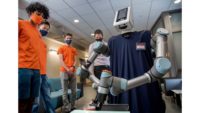Colleges and universities around the globe are leaders in education, research, and innovation, often serving as vital economic engines supporting thousands of valuable jobs and services across a local region. An evolution is underway to renew, decarbonize, and strengthen these community assets. This evolution took center stage at the International District Energy Association’s (IDEA’s) 33rd annual Campus Energy event, Feb. 10-14 in Denver.
The conference’s opening ceremonies, moderated by Rob Thornton, president and CEO, IDEA, featured a roundtable discussion focused on the power of change, specifically examining the changing structure of institutional campuses, the evolving needs of utilities, policy and regulatory paradigms, and the role of climate change.
ROB THORNTON: My first question is for Greg Coffin, who has spent 33 years at the University of Missouri. You’ve implemented a lot of change at the university, which has been recognized nationally by winning the IDEA System of the Year Award twice, in 2013 and 2017. You’re using a 66-MW CHP plant that used to burn coal. Describe the changes you’ve implemented at Mizzou?
GREG COFFIN: We have made some dramatic changes in our district energy operation over the last 10 years. We once operated a predominantly coal-fired facility. In fact, in 2008, we burned 182,000 tons of coal. A total of 95% of our energy was derived from coal. Today, that’s changed. We now have 35% coming from natural gas, 37% from biomass, and the balance is a little bit of coal that we use in the winter months. This change was driven by sustainability. We started down this path because we were seeking ways to reduce our carbon footprint. In 2008, natural gas prices were through the roof, which was followed by fracking. The price of gas has come down considerably since then. This all allowed us to diversify our fuel supply for our campus and become more efficient in the way we deliver energy.
THORNTON: The president of Yale University set what I’d call a fairly stiff, ambitious target back in 2005 when he announced a commitment to reducing greenhouse gas emissions 43% below 2005 numbers by 2020 as well as carbon neutrality by 2050. Sam, how is Yale doing with that?
SAM OLMSTEAD: We’re in a pretty good spot. Connecticut’s had a really good concentration of load management funding from our utility, so a lot of the building blocks for building demand-side energy management were already in place. We’ve also had some opportunities on the production side, as we converted one of our power plants to cogeneration, which provided a significant reduction. We’ve also developed on-site renewables — the biggest being a 1-MW photovoltaic array at our west campus. We’ve also invested in off-site renewables through a 50-MW wind farm in northern New England. And, then, you know, we’ve had some good luck along the way. New England’s grid supplied electricity at about 40% less carbon intensity than it was in 2005, which has helped us out quite a bit. When we put the goal together in 2005, we anticipated a mix of on-site development, off-site development, and the use of human activity for offsets. And that mix has put us just about on target, and we do expect to meet our goals.
THORNTON: Tim, in your role at Bond, you’re now helping institutions implement very complex projects, like CHP, energy storage, cogeneration, etc. Prior to joining Bond, you worked in utilities at Cornell University. How did that experience influence the work you’re doing now?
TIM PEER: I started out as a plant operator and eventually became the energy manager. It’s not easy to get projects off the ground in the university setting. That said, I always have my plant manager hat on. I don’t care what your budget schedule issues are, and I mean that. Building new facilities in tight footprints on urban campus settings that are considered hallowed ground is not easy. Having climate plans at institutions places many people under a lot of pressure.
THORNTON: Engie recently announced a 50-year concession agreement with the University of Iowa. In 2008, there was an extreme level of flooding that occurred at the main campus, resulting in like $750 million in lost utility systems. The steam complement sort of exacerbated the problem. Since then, Iowa has really modified its submarine doors on the terminals now. So, Michael, from climate change to risk mitigation to preparing for the future, what were the primary motivations for Iowa to enter into such a long-term agreement?
MICHAEL SCHACK: I think there are three major reasons. Like many universities, Iowa is determined to address climate change and reach its climate goals, which, as you may be aware, Iowa decided to eliminate all coal by 2025. The second factor is financial. Of the monetization of assets, $999 million will be set aside in a fund, which will help the university meet its strategic goals and retain students. The third reason is for the students to have some climate-centric experience. We have a network of applied research centers all over the world, so we provide internships and trainings for university students. We’re interested in pushing energy and climate change education forward.
THORNTON: Are students demanding more sustainable and renewable campuses? Are those voices impacting your planning and implementation of change?
COFFIN: Students are expecting these changes. They’re highly interested in a clean energy future. We’ve been engaged with our students to make sure we’re meeting their needs, and I think they recognize we can’t do everything immediately. It takes time. We’ve made great strides and cut our carbon emissions by 60%. That’s a great achievement, but we still have 40% to go, and it’s going to be very difficult to get that last 40%.
THORNTON: Scott, while you’re relatively new with Clearway, this is not your first rodeo. You’ve been involved in district energy for almost 30 years. Recently, Clearway announced an agreement with Duquesne University to integrate Duquesne’s district energy system into the downtown sector. How is that integration going?
SCOTT BARR: It’s going very well. You know, one of the challenges I think, moving forward, as universities increasingly try to monetize their assets, this has to be about more than just dollars. If it’s just about dollars, you have an inherent conflict from the beginning. And, as energy partners, we’re going to be wedded together for 30, 40, 50 years. When issues come up, the faculty, students, and local communities aren’t going to look to Clearway; they’re going to look at the university. So, it started with us both being good partners. We aligned philosophically and had common goals, which created a level of trust. If you don’t establish that trust, which comes from common goals, your problems are going to be a lot harder to resolve. We’re now on phase two of the project and we’ll be physically interconnecting the uptown plant and our university plant in August. That’ll take us to greater valleys once we connect those systems.
THORNTON: Doug, many of us have watched in horror at the tragic wildfires in California. It sometimes seems like California has a unique set of climate event challenges all of its own. In your role, how are you and your peers planning for a utility system that must be more robust, resilient, and available to withstand wildfires and anything and everything God can throw your way?
DOUG WELLS: You know, California has added a great deal to culture and pop culture across the entire U.S., and now we bring you the latest and greatest — the public safety power shutoff, or PSPS. So, in terms of pathways for energy resilience, in the face of both man-made disasters and natural disasters, it can be difficult to tell the difference between the two, especially in California. Earthquakes make big news, but some of the worst disasters have resulted from fires, which have been caused by a lack of maintenance on the infrastructure both in campus systems as well as utility systems. The worst outage we’ve experienced at Northridge in that last three years was a 12-hour outage in July 2017, which occurred when a four-year-old Los Angeles Department of Water power transformer simply blew out. This left 140,000 people in the San Francisco Valley without power through a sweltering July night. So, in terms of what we’re doing with the Cal State system, we continue to add to our thermal systems. Twenty-two of our 23 campuses have had district energy cooling and heating systems of some variety. So, we continue to add buildings to those systems. Sixteen of our 23 campuses have solar photovoltaic systems, amounting to close to 27 MW of installed capacity systemwide. We have five campuses with cogeneration systems and four campuses with fuel cells. Adding to that fleet, we’re adding an area of emergency generation in anticipation for moving the schools and the system into a microgrid-style system. We’re gathering as much money as we can in preparation of a renewal of the system’s infrastructure — primarily electrical but also heating and cooling — to prepare for the microgridding as utility, policy, and technology continues to evolve across the state.
THORNTON: What are your current carbon targets, and are these targets reasonable?
OLMSTEAD: Yale set a reduction target of 43% over 2005 by this year, and we did it. We’re also aiming to be carbon neutral by 2050. We’re pretty excited about our prospects of reaching that goal. You know, it involves a pretty significant capital expenditure beyond what the university spends already. But we think everybody kind of understands that. And it involves even more of a partnership, like I mentioned before, with the people who occupy our buildings and use them. From a utilities perspective, we are focused on steam pressure, water temperature, power outages to the campus, etc.
COFFIN: We’ve reduced carbon emissions by 60% at Iowa. We’ve built a renewable portfolio of about 38%-40%. That said, we recognize that the next steps are going to be very difficult. Every year we get a new crop of students with a new set of expectations, and they don’t know what the class before them has accomplished. They only want to know what you’re doing to move forward. We have to find a way to deal with the thermal energy portion. We all have large heat needs for our campuses, and trying to displace fuel supplies is going to be very difficult.
WELLS: California State University’s chancellor’s office actually set targets for the entire system. The target was to reduce greenhouse gases to 1990 levels by 2020 and 18% below 1990 levels by 2040. While I don’t have the statistics for the other schools within the institution, Northridge sits at 31% below our 1990 levels as of this year. We also set the additional goal of reducing our community’s carbon footprint to 1990 levels by 2020, and we’re 32% below that.
THORNTON: For those of you sitting in these chairs that you’re sitting in, the expectation is that you have to deliver on these objectives. So, what resources do you need? Is it master planning, capital planning, more partnerships?
BARR: I heard a great response from a student at a board meeting at a Midwestern university. At the meeting, the student was demanding divestiture of anything related to carbon fuels, and the CFO responded that he was not positioned to do that today. While it was something he said the university could consider in the long term, he did say that one way to decrease energy use would be to turn off the heat to all the dormitories. The student said, “You can’t do that.” So, the CFO replied, “Well, you’re asking other people to do things that are consequence-free to your existence, turning off the heat to the dorms is something tangible that we can do today to get us closer to the goal you’re proposing to support. When the result directly affects you, you don’t support it anymore.” The reality is, we’re governed by physics and economics, and we’ll remain governed by physics and economics. Sometimes, the people setting the goals don’t understand that, first and foremost, we have an educational responsibility. It’s easy to set goals. People in hell want ice water, but they can’t have it. It’s our goal as an industry and as an association to help people understand what those goals are and exactly what they mean. They cost money. Are they willing to bear the expenses that go along with these investments?







